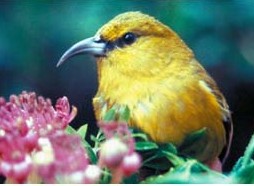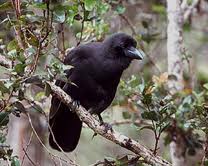Habitat of Rare Hawaiian Forest Birds Expanding
Three species of Hawaii’s rarest forest birds have been found at the lowest elevations in three decades, giving researchers hope for their continued survival.
The rediscovery of the three species occurred at the Hakalau Forest National Wildlife Refuge located on the northeast slopes of Mauna Kea, the US Fish and Wildlife Service and US Geological Survey said today.
The three species, the Hawaii creeper, Hawaii ‘akepa and ‘akiapola‘au, are believed to be highly susceptible to mosquito-transmitted diseases, including avian malaria.
It was thought the birds’ distribution was limited to cooler, higher elevations that are less favorable to mosquitoes.
Staff at the Hakalau refuge, which is controlled by the USFWS, heard the songs of the creeper and ‘akepa at the 4,200-foot elevation, within a mile of where they were last observed during a 1977 forest bird survey.
More importantly, scientists said, ‘akiapola‘au were heard and observed 1,000 feet lower in elevation from previous sightings in the 1970s.
They said these new observations significantly extend the current known range of these species at Hakalau.
“Hawaii’s native birds face multiple threats from habitat destruction, invasive species, introduced diseases, and climate change, with many already having been driven to extinction,” said USGS Director Marcia McNutt.
“The observation of three endangered species possibly expanding their range in a wildlife refuge gives us hope that with some care, the road to extinction need not be a one-way street,” she said.
Extensive forest bird surveys showed the area containing the refuge to be among the best-high-elevation rainforest habitats remaining in Hawaii, which led to the establishment of the Hakalau refuge in 1985. It is the only national wildlife refuge dedicated to the conservation and restoration of Hawaiian forest birds.
A 2005 USGS study noted that increased lowland sightings of the Hawaii ‘amakihi in the Puna district indicated that some native species have the capacity to evolve resistance to avian malaria.
In other news, the Hawaii Endangered Bird Conservation Program announced earlier this month that the captive breeding program for the endangered ‘alala or Hawaiian crow had been able to rear eight more of the birds this year.
That brought the total number of ‘alala in captivity to more than 100.
‘Alala, which were once commonplace in many areas of the Big Island, have not been seen in the wild since 2002 when biologists captured the last member of a released flock of the rare crows in a South Kona forest.
Efforts to re-establish the ‘alala in the wild had suffered a variety of setbacks. The captive-bred birds were suffering from diseases, including one spread by feral cats, and they were also falling prey to the Hawaiian hawk or ‘io, which itself is a threatened species. Efforts to relocate ‘io from the ‘alala’s area were unsuccessful.
Scientists are still optimistic that they will be able to re-establish a population of ‘alala in the wild.
















